Classification and Distribution of Traditional Grass-Roofed Dwellings in China Based on Deep Learning
Abstract
1. Introduction
- (1)
- Refinement of the classification of grass-roofed dwellings. By reassessing the differences between various grass-roofed dwellings and drawing a classification map, the study provides a basis for the conservation of diversity and sustainable construction of different types of grass-roofed dwellings.
- (2)
- Efficient construction of a large-scale distribution database of traditional grass-roofed dwellings. Through the development of a deep learning model, image data of grass-roofed buildings are collected through computer networks, and grass-roof features are extracted directly from the images for type recognition. This method overcomes the limitations of local data collection and realizes the construction of a nationwide classification and distribution database of traditional grass-roofed dwellings.
- (3)
- Improving the classification accuracy of different types of grass-roofed dwellings. By re-evaluating their distinctions and drawing distribution maps, this research provided a basis for the precise preservation of various grass-roofed dwellings and introduced a novel approach for the classification research of other traditional building materials.
2. Materials and Methods
2.1. Research Scope and Data Sources
- (1)
- Using ground-level perspective images that have rooflines and horizons exposed intact.
- (2)
- Ensure that the content of the images primarily focuses on traditional grass-roofed dwellings rather than other objects.
- (3)
- Grass material should be used as the main enclosure structure for roofs. Instances where grass are used as auxiliary materials to enhance adhesion and toughness will be excluded, e.g., flat roofs constructed of a mixture of sheep grass and clay, as seen in the Tun-domed dwelling in northeast China, should be avoided. This is because the use of such mixtures may not exhibit obvious herbaceous characteristics in visual features and could be misjudged as loess materials, thus affecting the effectiveness of the recognition model.
2.2. Research Framework
2.3. Methods
2.3.1. Classification of Traditional Grass-Roofed Dwelling Based on Grass Plant Family
2.3.2. Spatial Database Construction Based on Deep Learning
- (1)
- Building the training dataset
- (2)
- Model construction and evaluation
- (3)
- Image recognition and database construction
2.3.3. Distribution Analysis Based on ArcGIS
- (1)
- Nearest neighbor index
- (2)
- Kernel density analysis
2.3.4. Relevance Factor Analysis Based on Map Overlaying
3. Results
3.1. The Recognition Results
3.2. Spatial Distribution of Traditional Grass-Roofed Dwellings in China
3.2.1. Overall Spatial Distribution Showing Agglomeration
3.2.2. Spatial Distribution Difference of Grass-Roofed Dwelling Types
- (1)
- The thatch-roofed dwellings form multiple cluster regions in Yunnan, Guizhou, Hainan, Sichuan, Shaanxi, northern Zhejiang, and Shandong–Henan junction, presenting a pattern of multi-center distribution, and the most clustered areas are primarily located at provincial boundaries, far away from provincial administrative centers (Figure 8a).
- (2)
- The grain-grass-roofed dwellings are clustered in three main regions: Jiangsu–Shandong, southern Yunnan, and eastern Liaoning. While Heilongjiang Province in northeastern China lacks a prominent center of clustering, it still hosts a considerable number of grain-grass-roofed dwellings evenly distributed across the province (Figure 8b).
- (3)
- Unlike the first two, seagrass-roofed dwellings did not form a significant clustered pattern in spatial distribution but were mainly distributed in the south of the Bohai Sea, i.e., from the Bohai Strait to the tip of the Shandong Peninsula, and a small number of them spread southward to Jiangsu Province, while no distribution was found in other coastal areas of China (Figure 8c).
3.3. Factors on the Distribution of Grass-Roofed Dwellings
3.3.1. Natural Geographical Factors
- (1)
- Resource distribution pattern: acquisition of the grass materials
- (2)
- Precipitation: Grass growth environment and waterproof performance
- (3)
- Humidity: Insect and fire prevention
- (4)
- Air Temperature: Grass growth environment and thermal performance
- (5)
- Elevation: Vertical landscape differences and wind protection
3.3.2. Socio-Environmental Factors
- (1)
- Per capita GDP
- (2)
- Population Density
- (3)
- Road network density
- (4)
- The overall impact of socio-environmental factors
4. Conclusions
- (1)
- Traditional grass-roofed dwellings in China have a significant clustered distribution pattern primarily concentrated southeast of the Hu Line and in the fringe areas of China’s mainland. Among them, thatch-roofed dwellings are most widely distributed, with high intensity distribution cores in North, South, and Southwest China; grain-grass-roofed dwellings exhibit a predominant distribution in the northeastern regions, as well as in Shandong and its surrounding area; and a smaller number of seagrass-roofed dwellings are mainly distributed in the regions surrounding the Bohai Sea.
- (2)
- The natural environment has an essential influence on the original construction and distribution of traditional grass-roofed dwellings. Factors such as vegetation type, precipitation, temperature, humidity, elevation, etc., directly or indirectly impact the supply of suitable grass materials for roofing by influencing the growth pattern of grass. The environmental adaptability of grass material will also restrict the construction and distribution of grass-roofed dwellings. In general, the existing grass-roofed dwellings are mainly distributed in areas with higher rainfall, higher moisture index, milder temperatures, and lower elevations, and less distributed in areas that are rainless, arid, and have severe cold or extreme heat. As an ecological construction method closely related to natural resources, grass-roofed dwellings reflect the close interaction between humans and nature—that is, to make full and effective use of local materials while at the same time ensuring the buildings constructed by these materials adapt to local natural conditions. In this regard, traditional grass-roofed dwellings provided us with some inspiration.
- (3)
- Socio-environmental factors, including economic development levels, population distribution, and road network density, along with the process of regional modernization development, exert influence on the retention of the existing traditional grass-roofed dwellings through the substitution of new buildings for traditional dwellings. It was found that with the growth of economy, population, and modernization, the protection of traditional grass-roofed dwellings has been subjected to more impacts, but when the socio-economic development reaches a certain level, the emphasis on and effective use of traditional architectural culture will promote the retention of grass-roofed dwellings. This further highlights the importance and urgency of enhancing the awareness of the cultural values of traditional architecture. In addition, the modern adaptation of traditional grass-roofed dwellings and the application of traditional eco-wisdom in contemporary contexts are issues of significant relevance and merit further exploration.
5. Discussion
Author Contributions
Funding
Data Availability Statement
Acknowledgments
Conflicts of Interest
| 1 | Data Source: Xu, X. (2017). Spatially interpolated dataset of mean conditions of meteorological elements in China. Resource and Environmental Science Data Registration and Publication System. (http://www.resdc.cn/doi, accessed on 18 March 2024). https://doi.org/10.12078/2017121301. |
| 2 | Data Source: Xu, X., & Zhang, Y. (2017). Meteorological Background Dataset in China. Resource and Environmental Science Data Registration and Publication System. (http://www.resdc.cn/doi, accessed on 22 March 2024). https://doi.org/10.12078/2017121301. |
| 3 | Data Source: Xu, X. (2017). Spatially interpolated dataset of mean conditions of meteorological elements in China. Resource and Environmental Science Data Registration and Publication System. (http://www.resdc.cn/doi, accessed on 22 Feburary 2024). https://doi.org/10.12078/2017121301. |
| 4 | Date Source: Xu, X. (2017). Spatial distribution of kilometer grid GDP dataset in China. Resource and Environmental Science Data Registration and Publication System. (http://www.resdc.cn/doi, accessed on 22 March 2024). https://doi.org/10.12078/2017121102. |
| 5 | Data Source: Xu, X. (2017). Spatial distribution of kilometer grid population dataset in China. Resource and Environmental Science Data Registration and Publication System. (http://www.resdc.cn/doi, accessed on 22 March 2024). https://doi.org/10.12078/2017121101. |
| 6 | Data source: Grabbed from the Google map web. |
References
- Yang, J. Applied Research of Plant Materials in Ancient Chinese Architecture—Grass Bamboo Wood. Ph.D. Dissertation, Southeast University, Shenyang, China, 2018. Available online: https://kns.cnki.net/kcms2/article/abstract?v=KqXyGY4RJv1EYWHv7U77Sz2aoAMRkjON-q6carHjrW3aAkTL3Wz49X1Lp9oFMdzXktcnCDEqxMQMvsjvmGdu_E41tmTDHsCHa_L_sHVJweC3Q1FGKyhzkcywkCkiUYFtG7c0idTsinw-aAykWQ1LhCiLs-7CQRmFY1rDVIYyz1ZnRasWhDO-GQ==&uniplatform=NZKPT (accessed on 25 December 2023).
- Wang, W.; Zhou, L. Natural Zoning of Traditional Chinese Dwelling Forms. Archit. J. 1992, 38, 12–16. [Google Scholar]
- Wang, L. Cultural Regionalization Research on Construction Techniques of Han Traditional Dwellings in Northeast China. Master’s Thesis, Harbin Institute of Technology, Harbin, China, 2019. [Google Scholar] [CrossRef]
- Ji, S.Y.; Jun, H.J. Deep learning model for form recognition and structural member classification of east asian traditional buildings. Sustainability 2020, 12, 5292. [Google Scholar] [CrossRef]
- Wang, N.; Zhao, X.; Zhao, P.; Zhang, Y.; Zou, Z.; Ou, J. Automatic damage detection of historic masonry buildings based on mobile deep learning. Autom. Constr. 2019, 103, 53–66. [Google Scholar] [CrossRef]
- Siountri, K.; Anagnostopoulos, C.N. The classification of cultural heritage buildings in athens using deep learning techniques. Heritage 2023, 6, 3673–3705. [Google Scholar] [CrossRef]
- Dimitrov, A.; Golparvar-Fard, M. Vision-based material recognition for automated monitoring of construction progress and generating building information modeling from unordered site image collections. Adv. Eng. Inform. 2014, 28, 37–49. [Google Scholar] [CrossRef]
- Cheng, G. Research on Modern Architectural Space Construction Based on Straw Materials. Master’s Thesis, Nanjing University of the Arts, Nanjing, China, 2014. [Google Scholar]
- Oliver, P. Encyclopedia of Vernacular Architecture of the World; Cambridge University Press: New York, NY, USA, 1997; Available online: http://archive.org/details/encyclopediaofve0001unse_z0h2 (accessed on 28 February 2024).
- Uy, N.; Shaw, R. Shaped by Wind and Typhoon: The Indigenous Knowledge of the Ivatans in the Batanes Islands, Philippines. In Indigenous Knowledge for Disaster Risk Reduction: Good Practices and Lessons Learned from Experiences in the Asia-Pacific Region; United Nations International Strategy for Disaster Reduction: Bangkok, Thailand, 2008; pp. 59–63. Available online: https://www.academia.edu/16343023/Shaped_by_Wind_and_Typhoon_The_Indigenous_Knowledge_of_the_Ivatans_in_the_Batanes_Islands_Philippines (accessed on 28 February 2024).
- NHI, O.N.Y.; Hai, T.T.; Van Thuong, L. The Local Climate Adapting Characteristics of Traditional Buildings in Indochina-Sustainable Designs from Vernacular Architecture. Res. Militaris. 2022, 12, 1433–1441. Available online: https://resmilitaris.net/index.php/resmilitaris/article/view/1962 (accessed on 25 February 2024).
- Zhang, J.; Qiao, X. An Exploration of the Intrinsic Value of Thatched Houses in Ancient Canal Heritage Villages: A Study Based on Thatched Houses in Xinglong Village, Taierzhuang Region, Lunan. Huazhong Archit. 2008, 26, 166–171. [Google Scholar]
- Wang, J.; Li, X.; Yang, Q.; Wang, T. The ecological wisdom and craftsmanship of thatched roofs. Tradit. Chin. Archit. Gard. 2020, 37, 25–30. [Google Scholar]
- Chen, R. A Study on the Conservation Design of Traditional Residences in Hainan Li Flood Village Based on Locality. Master’s Thesis, Hainan Normal University, Haikou, China, 2023. [Google Scholar] [CrossRef]
- Steger, C. A roof of one’s own: Choice and access in global thatch sustainability. World Dev. Sustain. 2023, 3, 100088. [Google Scholar] [CrossRef]
- Zámolyi, F.; Herbig, U. Reed as building material-renaissance of vernacular techniques. In International Symposium on Advanced Methods of Monitoring Reed Habitats; Csaplovics, E., Schmidt, J., Eds.; Rhombos: Berlin, Germany, 2011; p. 83. Available online: https://www.researchgate.net/profile/Ulrike-Herbig-2/publication/318349101_Reed_as_building_material_-_renaissance_of_vernacular_techniques/links/5964f8caa6fdcc41b1d3c63a/Reed-as-building-material-renaissance-of-vernacular-techniques.pdf (accessed on 25 February 2024).
- Ministry of Housing and Urban-Rural Development of the People’s Republic of China. Tyological Collection of Traditional Chinese Dwellings; China Architecture & Building Press: Beijing, China, 2014. [Google Scholar]
- Dosdall, R.; Hahn, V.; Preuß, F.; Kreisel, H.; Miersch, J.; Schauer, F. Characterization of fungi of the genus Mycena isolated from houses thatched with Phragmites communis Trin. in Northern Germany: Enzyme pattern and reed decay. Int. Biodeterior. Biodegrad. 2014, 96, 174–180. [Google Scholar] [CrossRef]
- Ultralytics. Ultralytics YOLOv8 Docs. Home—Ultralytics YOLOv8 Docs. 2023. Available online: https://docs.ultralytics.com/zh/#yol (accessed on 2 February 2024).
- Qamar, S.; Baba, A.I.; Verger, S.; Andersson, M. Segmentation and Characterization of Macerated Fibers and Vessels Using Deep Learning. arXiv 2024, arXiv:2401.16937. [Google Scholar] [CrossRef] [PubMed]
- Su, H.; Wang, Y.; Zhang, Z.; Dong, W. Characteristics and influencing factors of traditional village distribution in China. Land 2022, 11, 1631. [Google Scholar] [CrossRef]
- Liao, Y.; Cenci, J.; Zhang, J. Chinese Modern Architectural Heritage Resources: Perspectives of Spatial Distribution and Influencing Factors. ISPRS Int. J. Geo-Inf. 2023, 12, 358. [Google Scholar] [CrossRef]
- Chen, M.; Gong, Y.; Li, Y.; Lu, D.; Zhang, H. Population distribution and urbanization on both sides of the Hu Huanyong Line: Answering the Premier’s question. J. Geogr. Sci. 2016, 26, 1593–1610. [Google Scholar] [CrossRef]
- Liu, M.; Zhou, Z. Application and construction process of thatched roofs. Constr. Archit. 2009, 19, 52–53. [Google Scholar]
- Wu, J.; Shen, C.; Zhang, J.; Zhou, X.; Han, S. Spatial pattern and its changes of grain production using GIS. IOP Conf. Ser. Earth Environ. Sci. 2018, 113, 012044. [Google Scholar] [CrossRef]
- Yin, X.; Lawrence, M.; Maskell, D.; Chang, W.-S. Construction and monitoring of experimental straw bale building in northeast China. Constr. Build. Mater. 2018, 183, 46–57. [Google Scholar] [CrossRef]
- International Union for the Conservation of Nature [IUCN]. IUCN Red List of Threatened Species. Search by Species Name. 2010. Available online: https://www.iucnredlist.org/ (accessed on 18 March 2024).
- Xu, S.; Zhang, Y.; Zhou, Y.; Xu, S.; Yue, S.; Liu, M.; Zhang, X. Warming northward shifting southern limits of the iconic temperate seagrass (Zostera marina). iScience 2022, 25, 104755. [Google Scholar] [CrossRef] [PubMed]
- Wang, S.; Cui, Y.; Liu, J.; Xia, Z. Research progress on seagrass and seagrass ecosystems. Acta Pratacult. Sin. 2016, 25, 149–159. Available online: http://cyxb.lzu.edu.cn/EN/volumn/current.shtml (accessed on 1 April 2024).
- Gong, T.; Li, C. Simple practical wisdom: A study on the construction techniques of the floor boat-shaped house of the Li ethnic group in Hainan. ZHUANGSHI 2022, 10, 88–93. [Google Scholar] [CrossRef]
- Lu, Q. Hainan HongKong Macau Ancient Architecture; China Building Industry Press: Beijing, China, 2015. [Google Scholar]
- Zhang, T. Study on Climate Adaptability of Typical Traditional Dwellings Envelope. Ph.D. Dissertation, Xi’an University of Architecture and Technology, Xi’an, China, 2014. Available online: https://kns.cnki.net/kcms2/article/abstract?v=KqXyGY4RJv3rr2QaJe2zog_I2VavgmT9R1WwiOsIwyNWIC9P3cp5uBVTc3ABO_i6oqmUVDjx137GHFiMLaLe7WPLiFJxVWfQWElYV61SGgB6FBx0gt-NE4IPBBmcIGBH61IeuKIveY6bpGO1b1tvF0pbKHIQS4UfGzlK0SgmxYE=&uniplatform=NZKPT (accessed on 1 April 2024).
- Short, F.; Carruthers, T.; Dennison, W.; Waycott, M. Global seagrass distribution and diversity: A bioregional model. J. Exp. Mar. Biol. Ecol. 2007, 350, 3–20. [Google Scholar] [CrossRef]
- Li, X.; Wang, K.; Zhang, S.; Feng, M. Distribution and flora of seaweed beds in the coastal waters of China. Sustainability 2021, 13, 3009. [Google Scholar] [CrossRef]
- Shi, Y.; Fan, H.; Cui, X.; Pan, L.; Li, S.; Song, X. Overview on seagrasses and related research in China. Chin. J. Oceanol. Limnol. 2010, 28, 329–339. [Google Scholar] [CrossRef]
- Davies, P.; Morvan, C.; Sire, O.; Baley, C. Structure and properties of fibres from sea-grass (Zostera marina). J. Mater. Sci. 2007, 42, 4850–4857. [Google Scholar] [CrossRef]
- China Academy of Building Research (n.d.). Thermal Design Code for Civil Building (GB50176-2016); China Architecture & Building Press: Beijing, China. Available online: https://www.mohurd.gov.cn/gongkai/zhengce/zhengcefilelib/201702/20170214_230579.html (accessed on 3 April 2024).
- Yang, Q. The Environmental Suitability of Enclosure of Vernacular Dwellings in Northeast China from the Material Perspective. Qingdao University of Technology. Master’s Thesis. 2020. Available online: https://link.cnki.net/doi/10.27263/d.cnki.gqudc.2020.000028 (accessed on 26 October 2023).
- Yang, J. A Study on the Application of Grass Materials in Ancient Chinese Architecture. Archit. J. 2019, 10, 46–53. [Google Scholar]
- Karyono, T.H.; Suwantara, I.K.; Nugrahaeni, R.; Suprijanto, I.; Vale, R. Temperature performance and thermal comfort study in vernacular houses in East Nusa Tenggara, Indonesia. In Proceedings of the 7th Windsor Conference: The Changing Context of Comfort in an Unpredictable World Cumberland Lodge, Windsor, UK, 12–15 April 2012; pp. 12–15. [Google Scholar]
- Fullen, M.A. Agro-environmental sustainability of the Yuanyang rice terraces of Yunnan (China): Lessons for Europe. In Protection of the Ecological and Productivity Functions in a Pan European Context: International Conference of ESSC, Průhonice, Czech Republic, 22–25 June 2009; University of Wolverhampton: Wolverhampton, UK, 2009; pp. 12–18. Available online: http://hdl.handle.net/2436/108337 (accessed on 27 February 2024).
- CMA Wind and Solar Center. China Wind and Solar Energy Resources Bulletin; CMA Wind and Solar Center: Beijing, China, 2024. [Google Scholar]
- Ren, Y. The Real Situation, Value and Path of Traditional Village Protection. Acad. Res. 2023, 12, 47–53. [Google Scholar]
- National Bureau of Statistics of the People’s Republic of China. Statistical Bulletin on National Economic and Social Development in 1995. 2001. Available online: https://www.stats.gov.cn/sj/tjgb/ndtjgb/qgndtjgb/202302/t20230206_1901939.html (accessed on 1 April 2024).
- Kang, J.; Zhang, J.; Hu, H.; Zhou, J.; Xiong, J. Analysis on the spatial distribution characteristics of Chinese traditional villages. Prog. Geogr. 2016, 35, 839–850. [Google Scholar]
- Mizukami, T. A Comparative Study of Building Regulations and Fire Protection Methods on Thatched Rooves in the United Kingdom, Denmark, the Netherlands and Japan. Fire Technol. 2023. [Google Scholar] [CrossRef]
- Bouza, H.E.; Asut, S. Advancing reed-based architecture through circular digital fabrication. In Proceedings of the eCAADe 2020 (Online): 38th International Conference on Education and Research in Computer Aided Architectural Design in Europe, Berlin, Germany, 16–18 September 2020; pp. 117–126. Available online: http://papers.cumincad.org/cgi-bin/works/paper/ecaade2020_240 (accessed on 1 April 2024).
- Vimalraj, A.; Jeyasubramanian, K.; Baskar, I. Sustainable building envelopes: Evaluating the thermal performance of thatched roofs fabricated using coconut leaves. Sustain. Chem. Pharm. 2024, 42, 101771. [Google Scholar] [CrossRef]
- Wu, F.; Wang, C.; Zhang, B.; Zhang, H.; Gong, L. Discrimination of collapsed buildings from remote sensing imagery using deep neural networks. In Proceedings of the IGARSS 2019-2019 IEEE International Geoscience and Remote Sensing Symposium, Yokohama, Japan, 28 July–2 August 2019; pp. 2646–2649. [Google Scholar] [CrossRef]
- Qiu, G.; Yin, H.; Xie, W.; He, L.; Ao, Z. Research on vegetation information extraction in the area of important buildings based on remote sensing image. Mol. Vis. 2011, 18, 1395–1401. [Google Scholar] [CrossRef]
- Walker, R.S.; Hamilton, M.J.; Groth, A.A. Remote sensing and conservation of isolated indigenous villages in Amazonia. R. Soc. Open Sci. 2014, 1, 140246. [Google Scholar] [CrossRef] [PubMed]
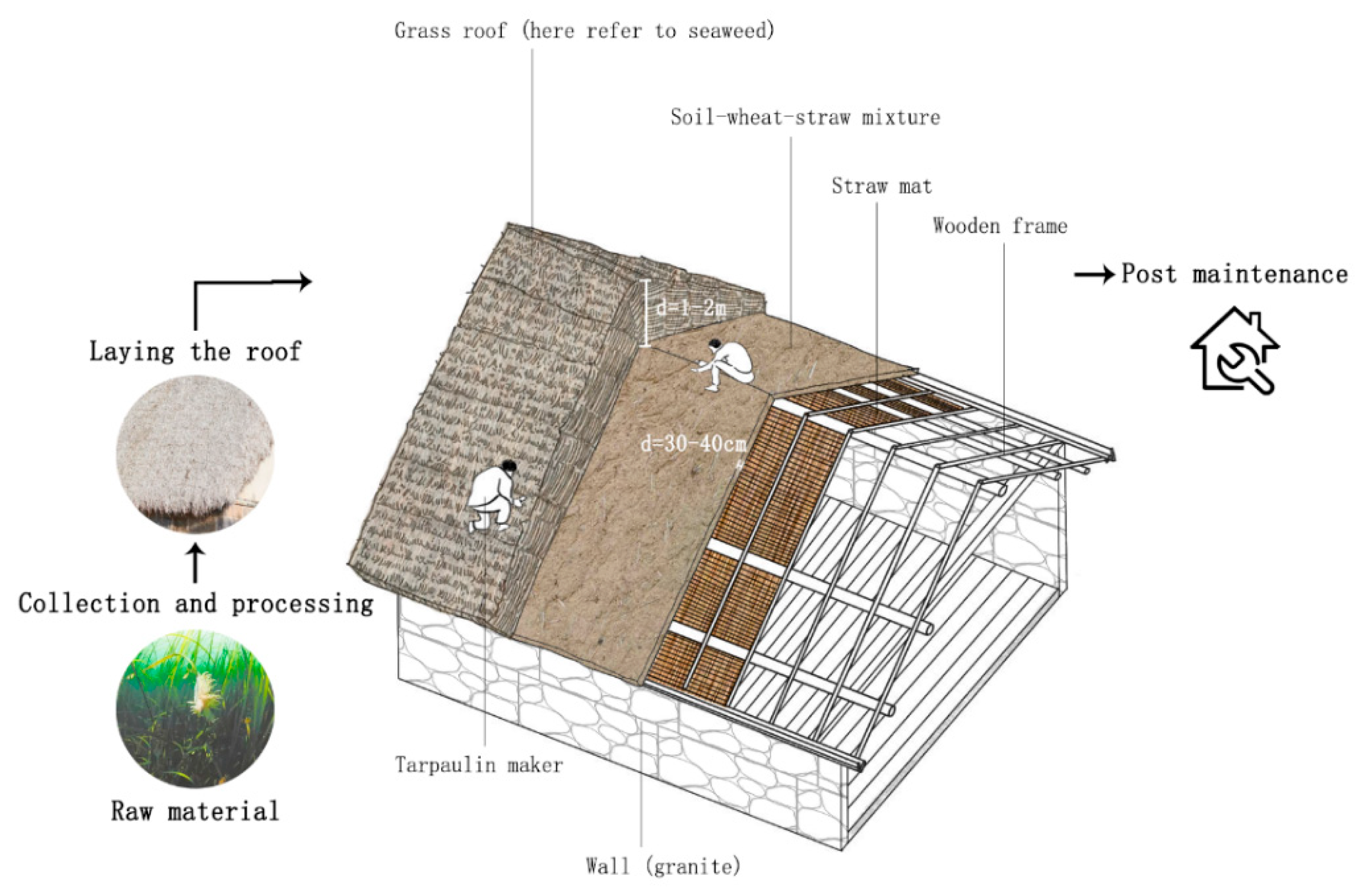

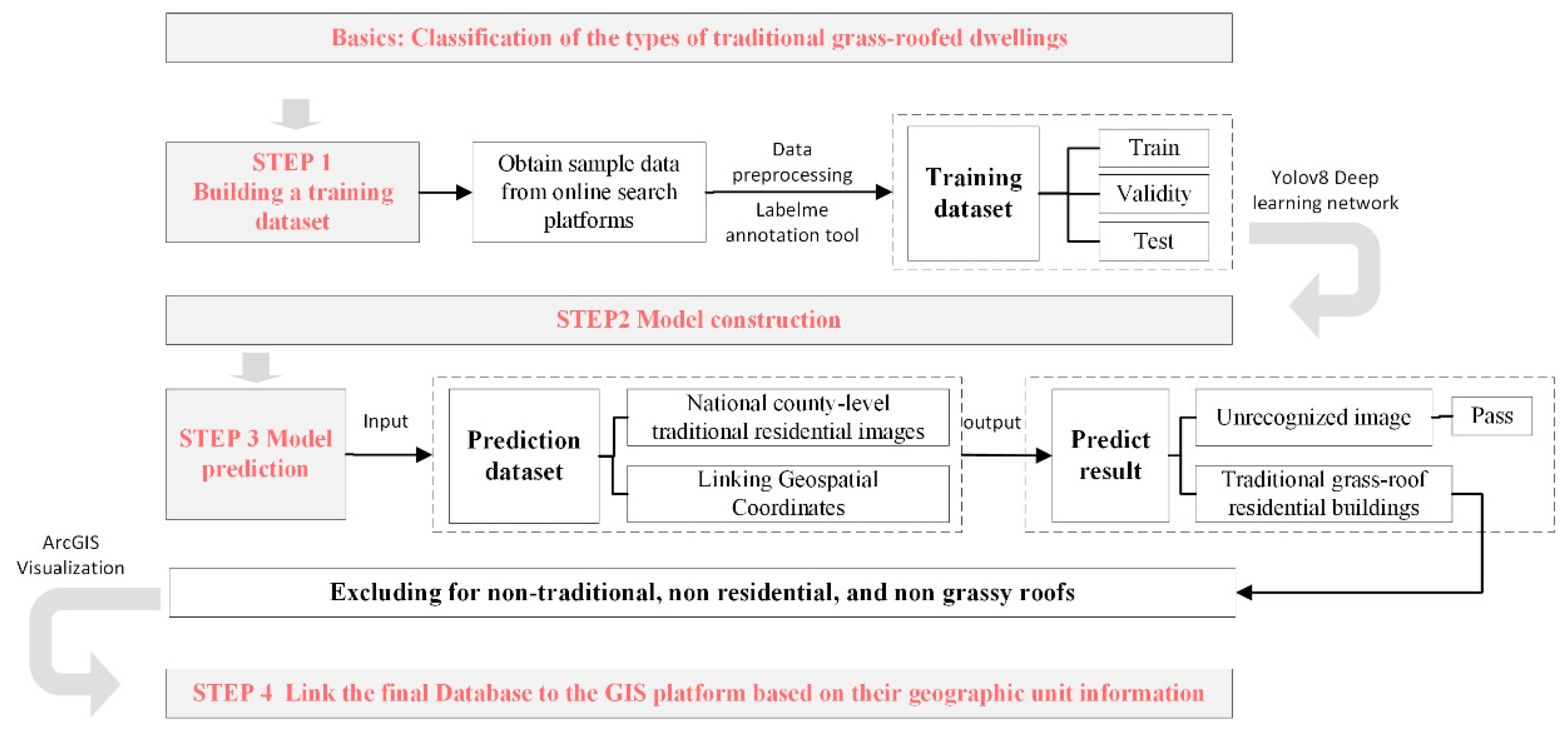
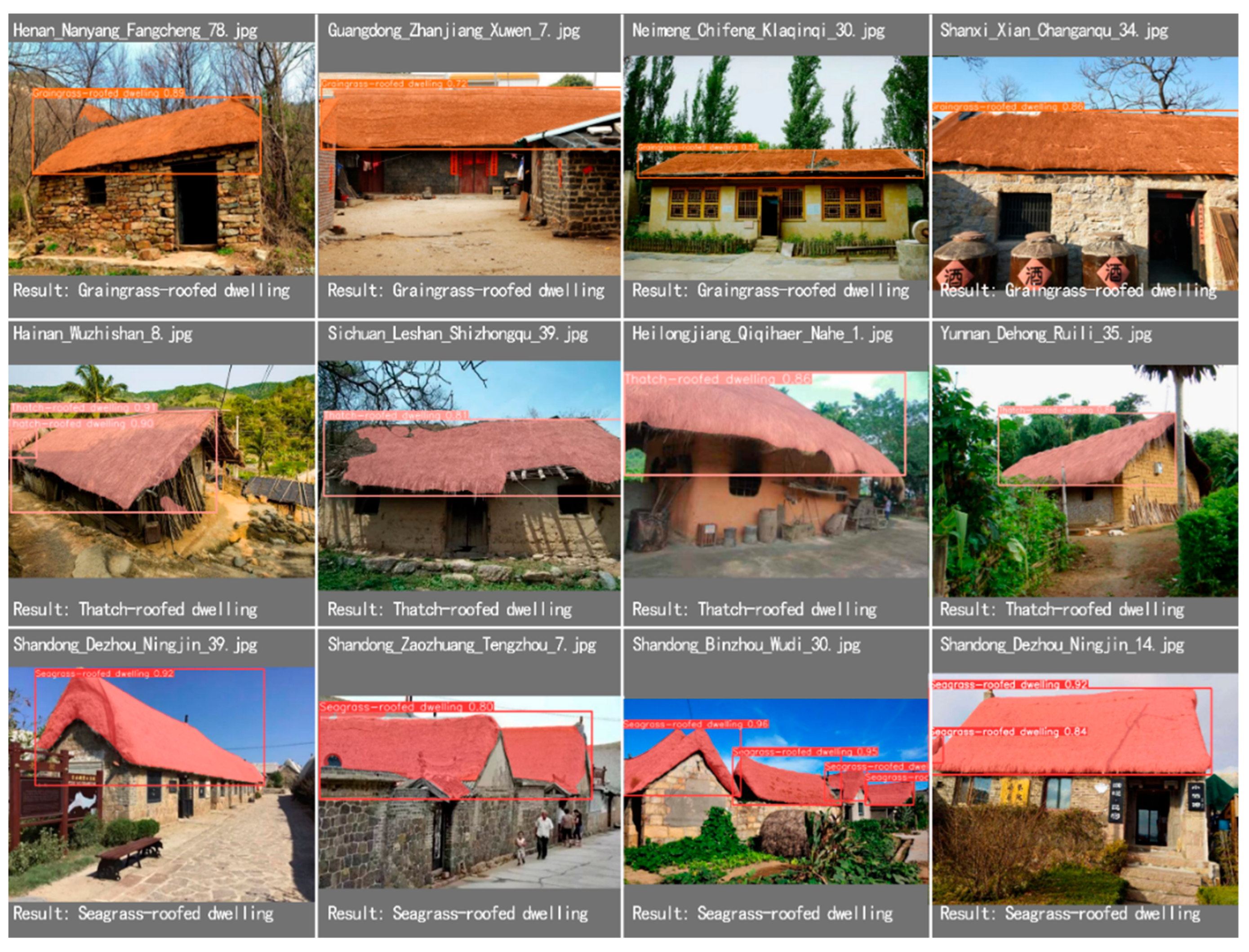
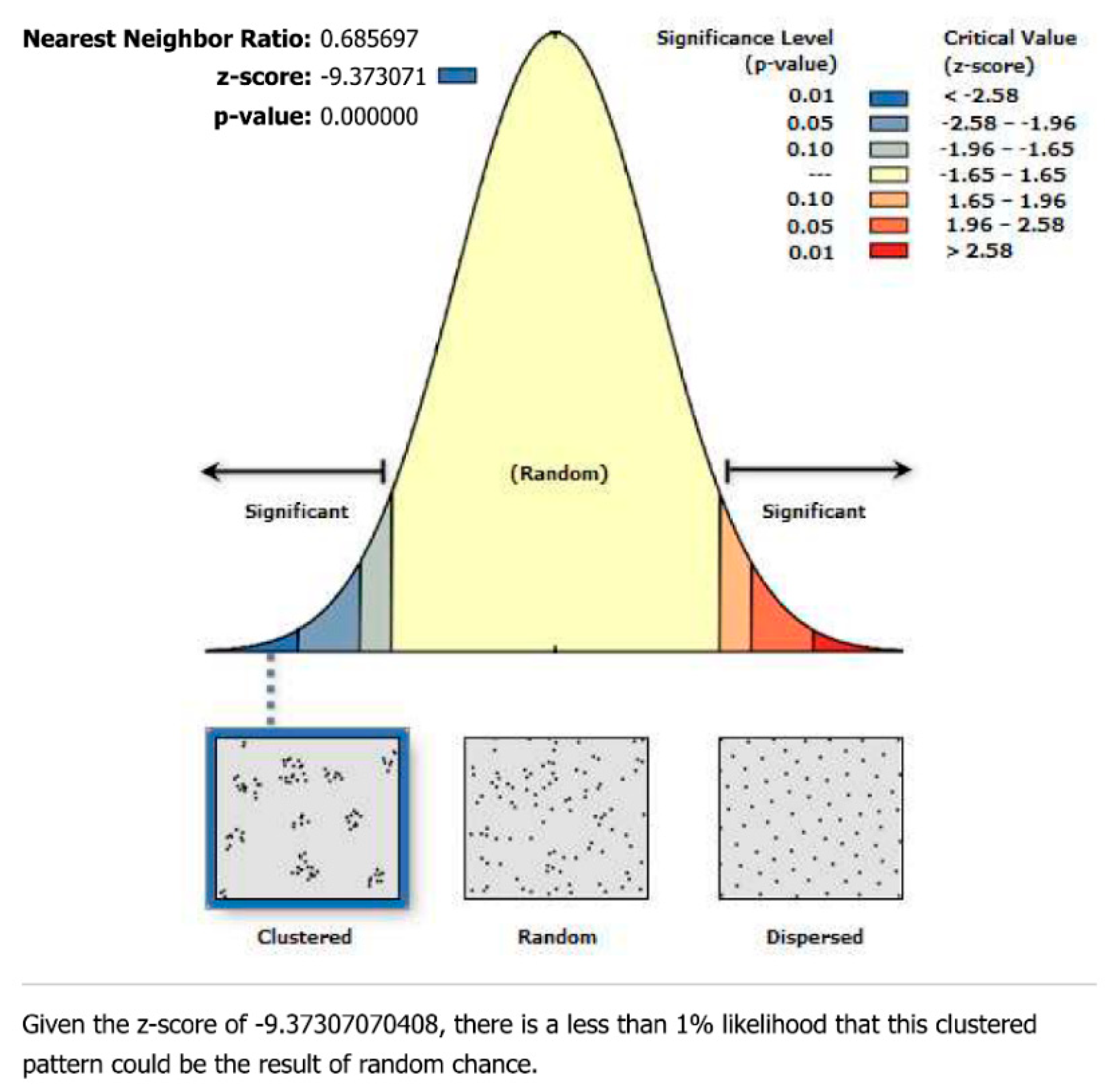
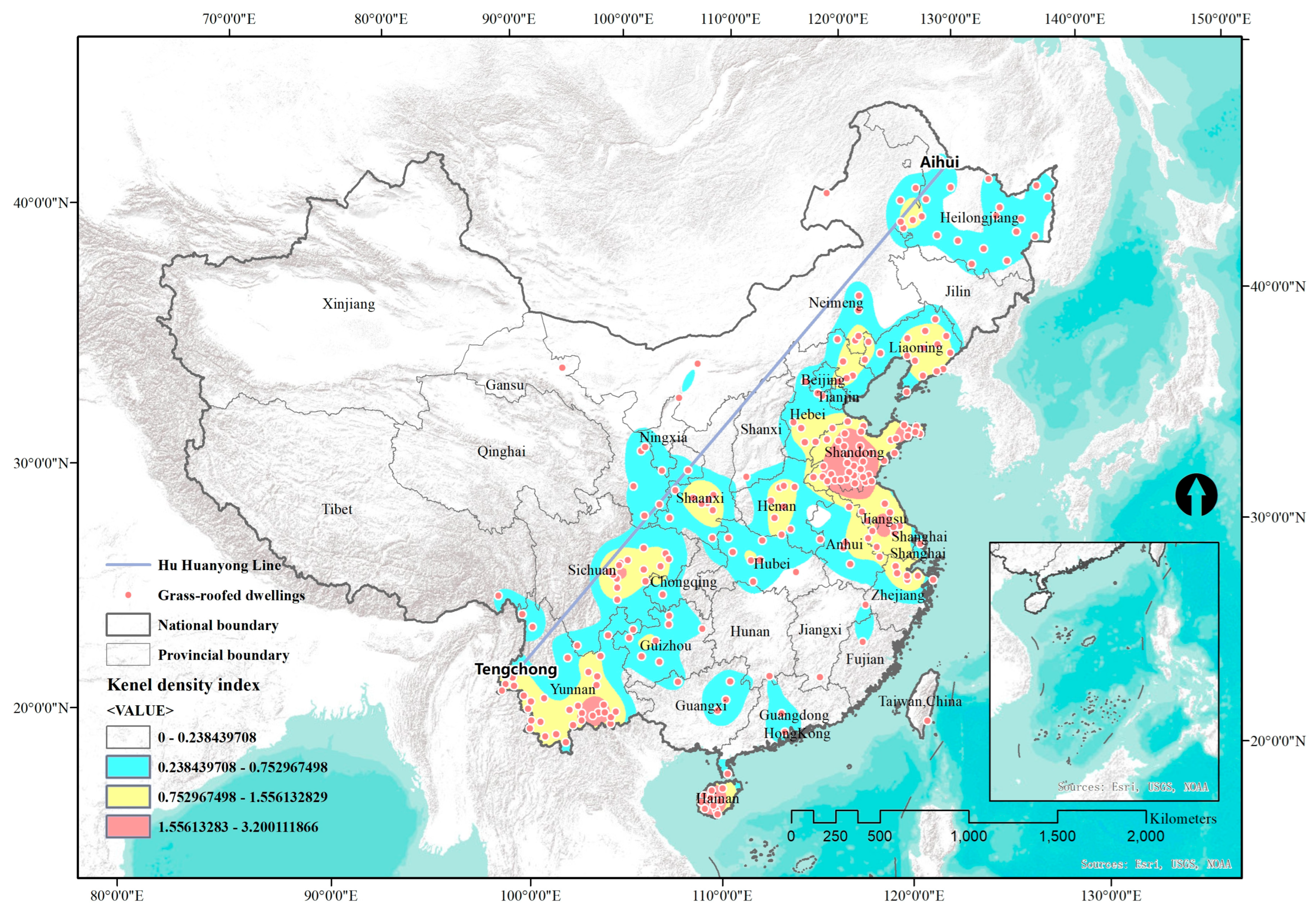
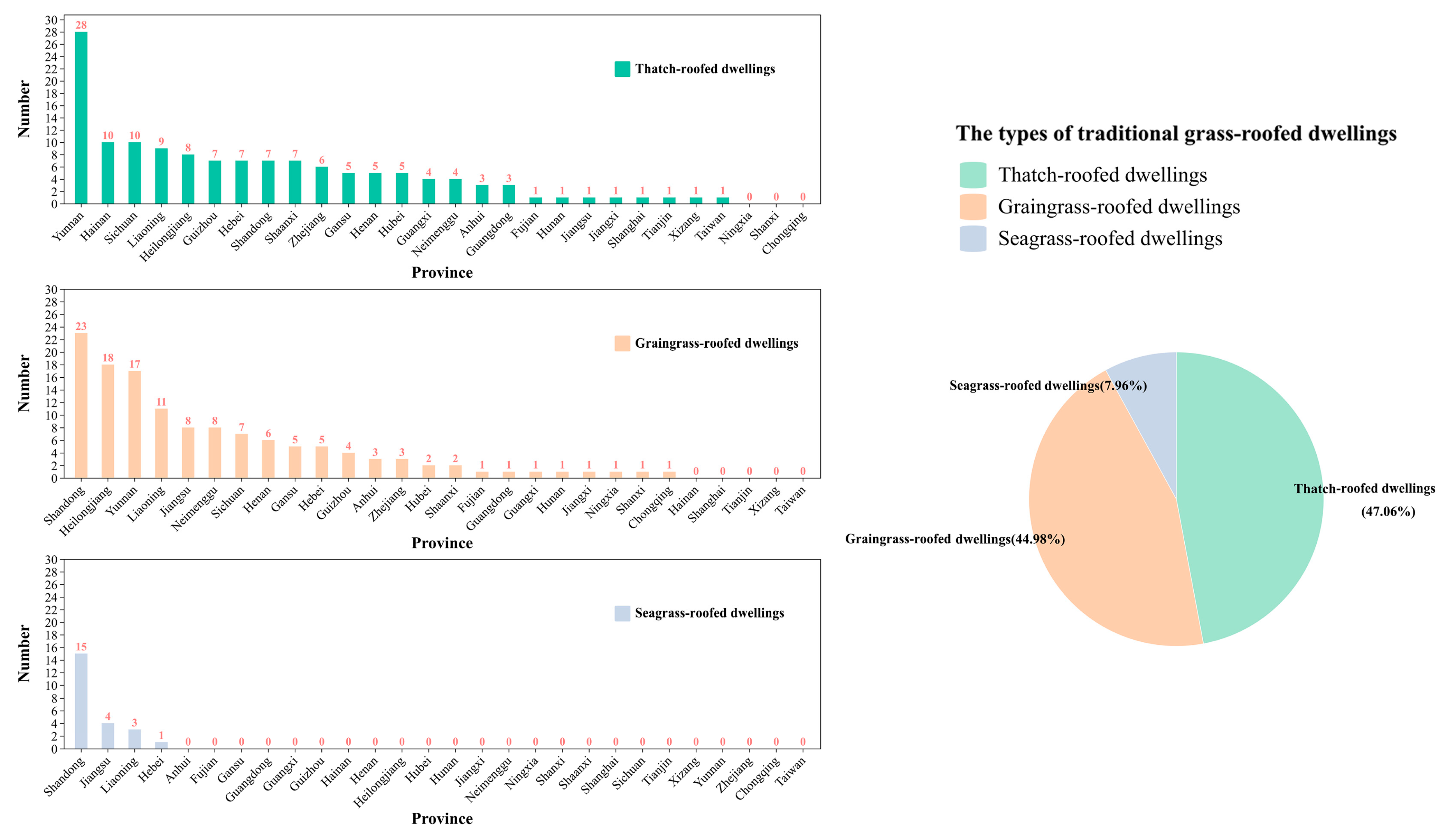


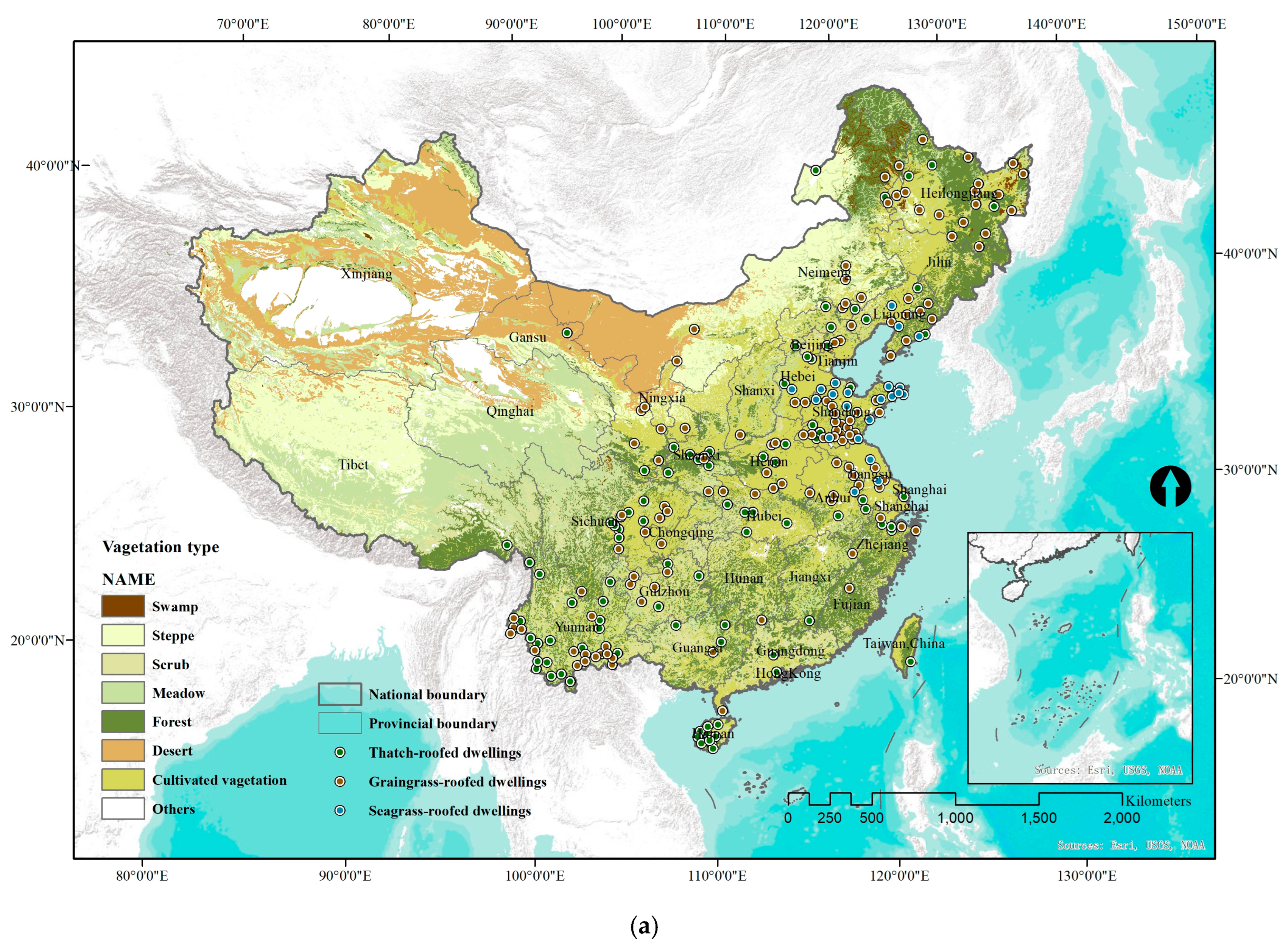


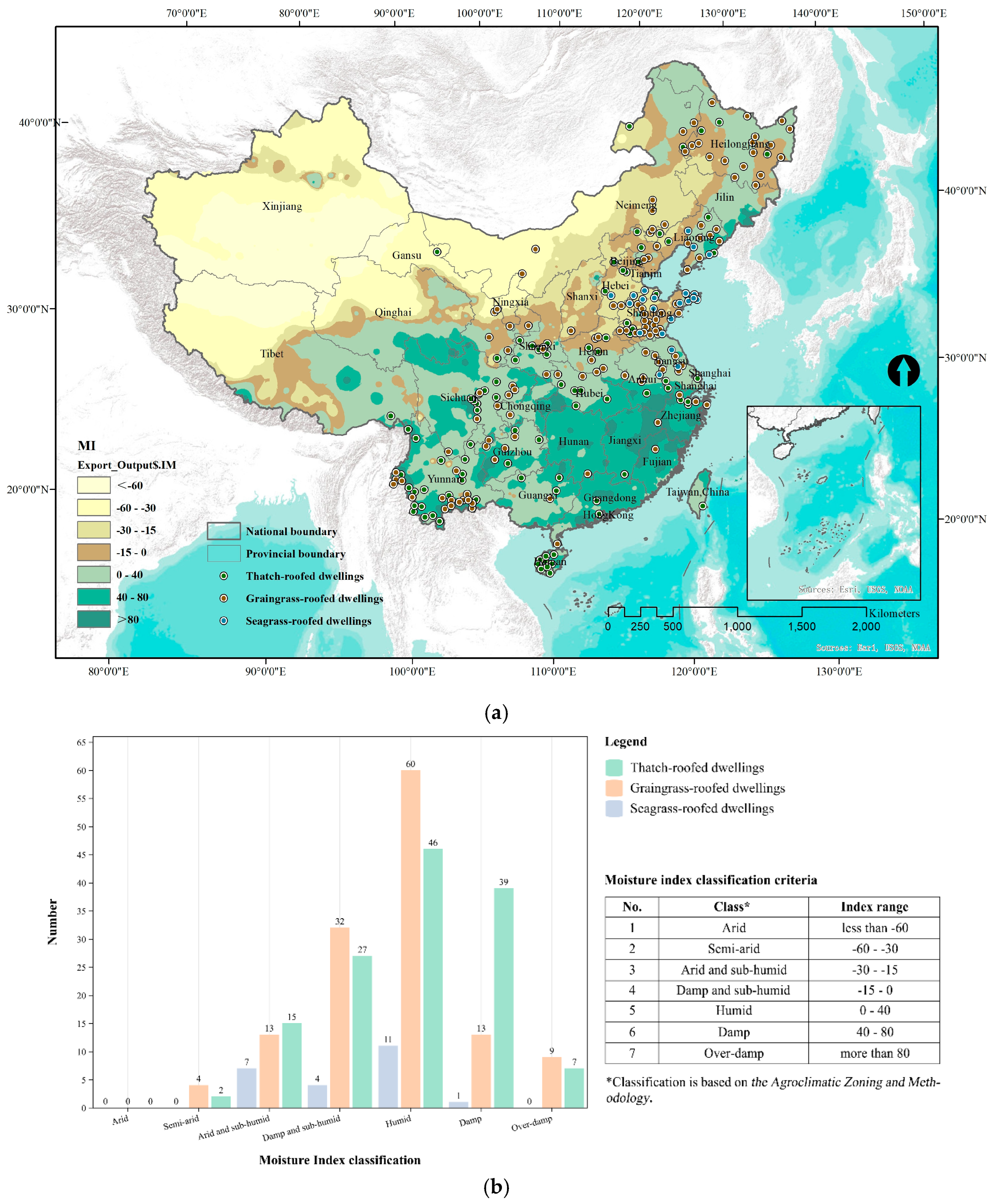

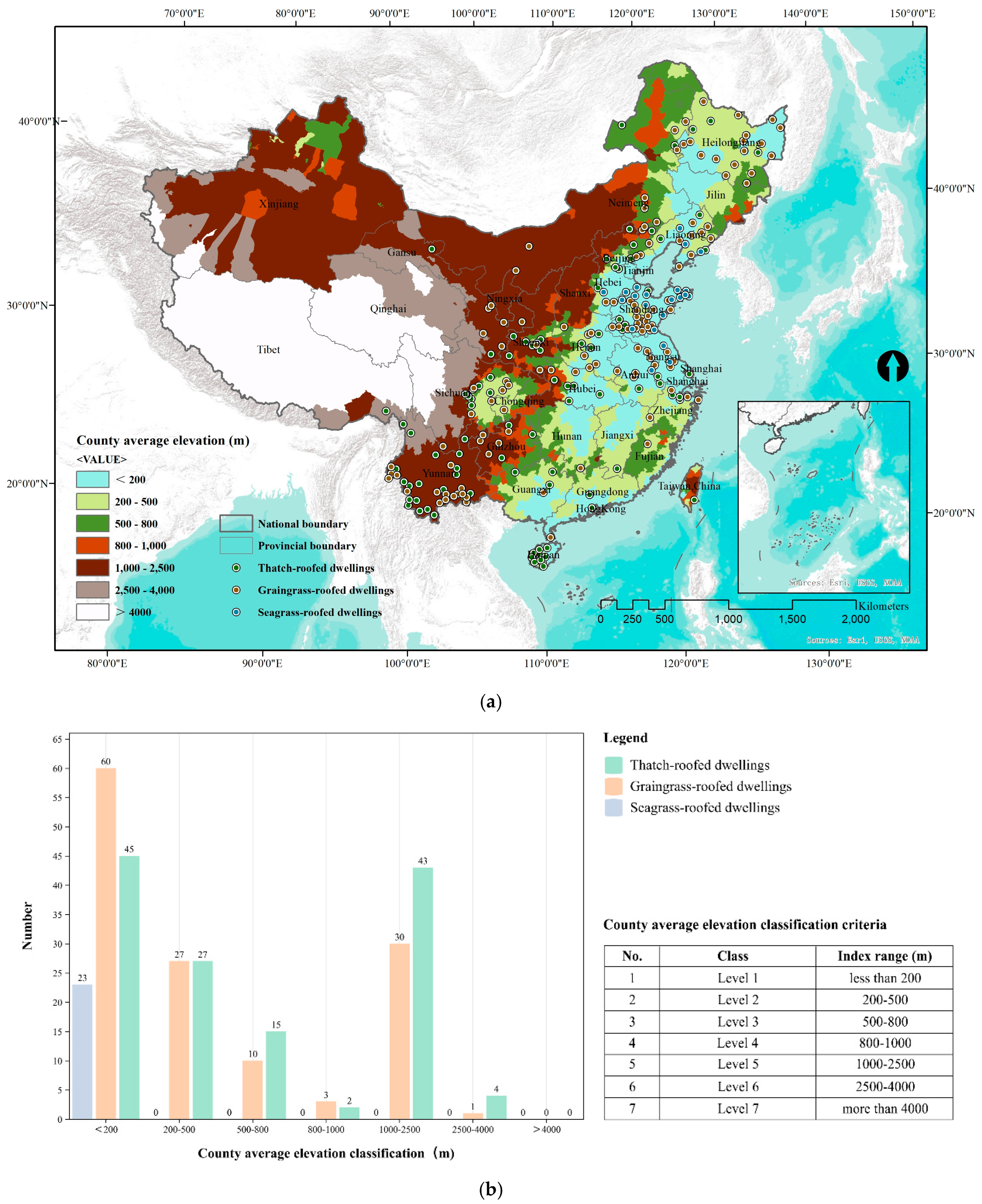

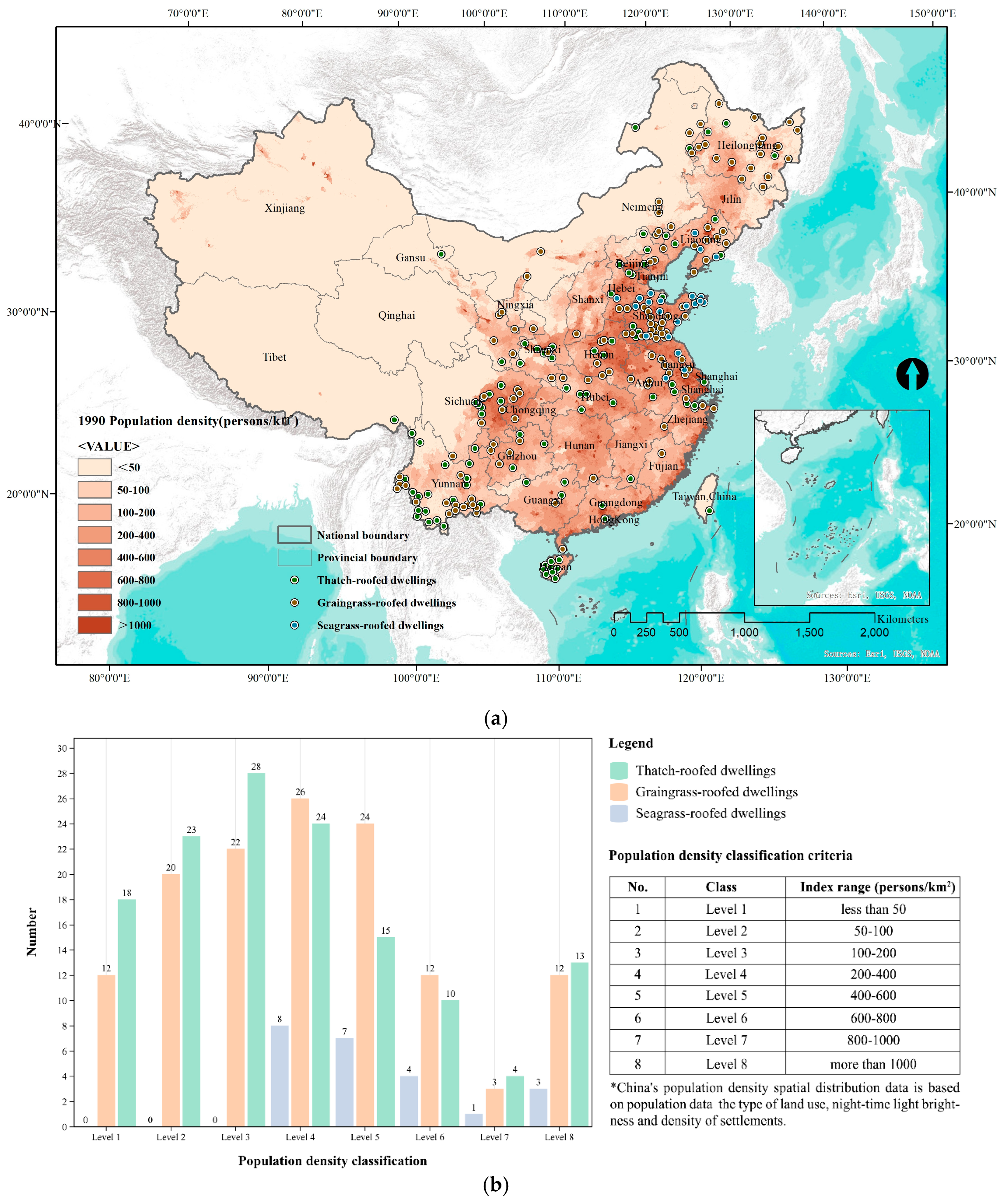

| Data Type | Data Sources | Data Volume and Format | Note | |
|---|---|---|---|---|
| Training dataset | Public images collected from Bing web search platform based on the known cases of grass-roofed dwellings listed in authoritative sources | 342 pieces of raw JPG images | 1400 pieces of enhanced JPG images | |
| Prediction dataset * | Public images in 2853 county-level units obtained on the web search engine Bing by python script | Adopting the first 100 images obtained for each county, making a total of 258,300 | Search images using “administrative district + traditional folk dwellings” as keywords | |
| Filtered dataset | Filtered from the predicting outcomes | 474 JPG images in total | Screening images of traditional grass-roofed dwellings and removing images containing modern dwellings | |
| Vagetation type | RESDC | raster data | Nationwide | |
| Annual precipitation | RESDC | raster data | Nationwide in 1970 | |
| Moisture index | RESDC | raster data | Nationwide | |
| Annual average temperature | RESDC | raster data | Nationwide in 1970 | |
| Digital elevation model | RESDC | raster data | Nationwide | |
| Spatial distribution of GDP | RESDC | raster data | Nationwide in 1995 | |
| Spatial distribution of Population | RESDC | raster data | Nationwide in 1990 | |
| Road network | Web crawler | vector data | Nationwide in 1990 | |
| Type | Material Family | Material Properties | Appearance Characteristic | The Morphology of Raw Materials | Typical Example |
|---|---|---|---|---|---|
| Thatch-roofed dwellings | Herbs, perennial, with long stout rhizomes | Anti-corrosion Pest control Moisture proof | Mostly green when fresh, with stiff, straight stems, turning yellow when dried off the soil, with hairy spikes on the roof and protruding leaves. |  | 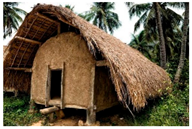 |
| Grain-grass-roofed dwellings | Stems, leaves, or stalks of food crops [18] | High toughness Heat insulation Damp-proof Soundproof | Yellow at maturity, black after oxidation off the soil. The roofs are chaffy with rough texture. |  |  |
| Seagrass-roofed dwellings | Higher angiosperms that survive in seawater | Anti-corrosion Flame retardant Heat insulation High strength colloidal fibers | Green when fresh, purple–brown when dried, and then gradually whitening due to the chemical reaction of the gel in the seagrass species with the environment. The roofs are neat with soft texture. | 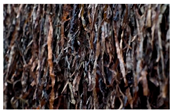 |  |
| Data | Valid Image Amount | Total Valid Amount | Enhanced Image Amount | Final Image Amount |
|---|---|---|---|---|
| Thatch-roofed dwellings | 122 | 342 | 490 | 1400 |
| Grain-grass-roofed dwellings | 102 | 405 | ||
| Seagrass-roofed dwellings | 118 | 505 |
| Assessment of Indicators | Overall Recognition Model (Box *, Mask *) | Recognition Results of Single Type (Box *, Mask *) | ||||||
|---|---|---|---|---|---|---|---|---|
| Thatch-Roofed Dwellings | Grain-Grass-Roofed Dwellings | Seagrass-Roofed Dwellings | ||||||
| Recall | 0.76 | 0.753 | 0.729 | 0.729 | 0.681 | 0.66 | 0.869 | 0.867 |
| Precision | 0.876 | 0.867 | 0.837 | 0.837 | 0.881 | 0.854 | 0.909 | 0.909 |
| mAP | 0.879 | 0.866 | 0.825 | 0.807 | 0.843 | 0.847 | 0.97 | 0.945 |
| Category | Recognition Results | Valid Results after Manual Screening | Cases Covered by Existing Studies | |||
|---|---|---|---|---|---|---|
| Num of Images | Coverage (Num of Counties) | Num of Images | Coverage (Num of Counties) | Num of Specific Cases | Coverage (Num of Counties) | |
| Thatch-roofed dwellings | 239 | 135 | 208 | 136 | 22 | 41 |
| Grain-grass-roofed dwellings | 201 | 130 | 188 | 131 | 7 | 12 |
| Seagrass-roofed dwellings | 86 | 28 | 81 | 23 | 5 | 9 |
| Total | 526 | 293 | 474 | 290 | 34 | 62 |
| Name and Number of the Image | Recognition Results | Map Points and Remarks | ||
|---|---|---|---|---|
| Marking | Labeling and Photograph | X | Y | |
| Lingbi_0 | 1 | Grain-grass-roofed dwelling | 117.531189 | 33.686076 |
 | 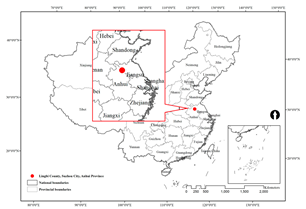 | |||
| Dongfang_52 | 1 | Thatch-roofed dwelling | 108.839842 | 18.994769 |
 | 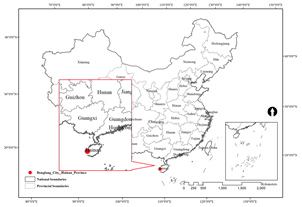 | |||
| Ningjin_39 | 1 | Seagrass-roofed dwelling | 116.801001 | 37.679721 |
 |  | |||
| Fugu_10 | 0 | - | - | - |
 | Image of non-traditional grass-roofed dwellings | |||
| Thatch-Roofed Dwellings | Grain-Grass-Roofed Dwellings | Seagrass-Roofed Dwellings | |
|---|---|---|---|
| Observed mean distance (m) | 95,998.38 | 85,318.87 | 91,902.39 |
| Expected mean distance (m) | 136,059.31 | 116,440.85 | 82,615.96 |
| Nearest neighbor index R | 0.705563 | 0.732723 | 1.112405 |
| Z-score | −6.568907 | −5.852324 | 1.031287 |
| Significance p | <0.01 | <0.01 | >0.1 |
| Clustering test report |  | 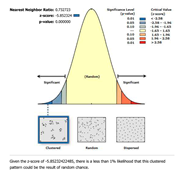 |  |
Disclaimer/Publisher’s Note: The statements, opinions and data contained in all publications are solely those of the individual author(s) and contributor(s) and not of MDPI and/or the editor(s). MDPI and/or the editor(s) disclaim responsibility for any injury to people or property resulting from any ideas, methods, instructions or products referred to in the content. |
© 2024 by the authors. Licensee MDPI, Basel, Switzerland. This article is an open access article distributed under the terms and conditions of the Creative Commons Attribution (CC BY) license (https://creativecommons.org/licenses/by/4.0/).
Share and Cite
Tao, J.; Zeng, Y.; Zhuo, X.; Wang, Z.; Xu, J.; Ren, P. Classification and Distribution of Traditional Grass-Roofed Dwellings in China Based on Deep Learning. Land 2024, 13, 1595. https://doi.org/10.3390/land13101595
Tao J, Zeng Y, Zhuo X, Wang Z, Xu J, Ren P. Classification and Distribution of Traditional Grass-Roofed Dwellings in China Based on Deep Learning. Land. 2024; 13(10):1595. https://doi.org/10.3390/land13101595
Chicago/Turabian StyleTao, Jin, Yuxin Zeng, Xiaolan Zhuo, Zhibo Wang, Jihang Xu, and Peng Ren. 2024. "Classification and Distribution of Traditional Grass-Roofed Dwellings in China Based on Deep Learning" Land 13, no. 10: 1595. https://doi.org/10.3390/land13101595
APA StyleTao, J., Zeng, Y., Zhuo, X., Wang, Z., Xu, J., & Ren, P. (2024). Classification and Distribution of Traditional Grass-Roofed Dwellings in China Based on Deep Learning. Land, 13(10), 1595. https://doi.org/10.3390/land13101595






